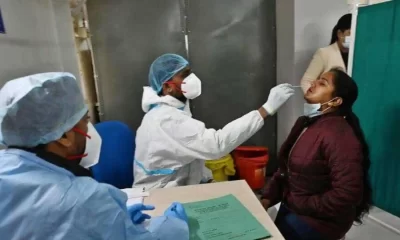India News
Omicron scare: Centre writes to States, UTs amidst rising cases, says activate war rooms, consider night curfews
After the second wave, the world is dreaded by the possible third wave of coronavirus. Recently, there has been surge in the number of Omicron cases in the world, and India has so far reported 213 cases of Omicron, at the time of writing this article.

India News
BJP and Shiv Sena reach broad seat-sharing deal ahead of BMC elections
BJP and Shiv Sena are close to finalising seat-sharing for 200 wards ahead of the BMC elections, while opposition parties intensify alliance talks across Maharashtra.
India News
Op Aaghat 3.0: Delhi police arrest over 280 accused ahead of New Year celebrations
Delhi police arrested over 280 accused and detained more than 1,300 individuals under Operation Aaghat 3.0 ahead of New Year, seizing weapons, drugs, liquor and stolen items.
India News
Over 2,000 Maoists surrender under Chhattisgarh rehabilitation policy, says CM Vishnu Deo Sai
Chhattisgarh Chief Minister Vishnu Deo Sai said more than 2,000 Maoists have surrendered under the state’s rehabilitation policy, which offers skill training, financial assistance and land support.
-

 India News22 hours ago
India News22 hours agoAAP targets Delhi LG with Ghajini dig over pollution row, BJP hits back
-

 Entertainment22 hours ago
Entertainment22 hours agoDhurandhar box office collection crosses Rs 1,000 crore worldwide in 21 days
-

 Latest world news21 hours ago
Latest world news21 hours agoIndia flags attacks on Hindus in Bangladesh as worrisome after recent lynchings
-

 India News22 hours ago
India News22 hours agoTraffic slows in Himachal Pradesh as year-end tourist rush chokes roads to Shimla, Manali
-

 India News4 hours ago
India News4 hours agoCBI moves Supreme Court against suspension of Kuldeep Sengar’s life sentence in Unnao rape case
-

 India News3 hours ago
India News3 hours agoBangladeshi singer James’ concert cancelled after mob attack in Faridpur
-

 India News3 hours ago
India News3 hours agoOver 2,000 Maoists surrender under Chhattisgarh rehabilitation policy, says CM Vishnu Deo Sai
-

 India News3 hours ago
India News3 hours agoOp Aaghat 3.0: Delhi police arrest over 280 accused ahead of New Year celebrations


















